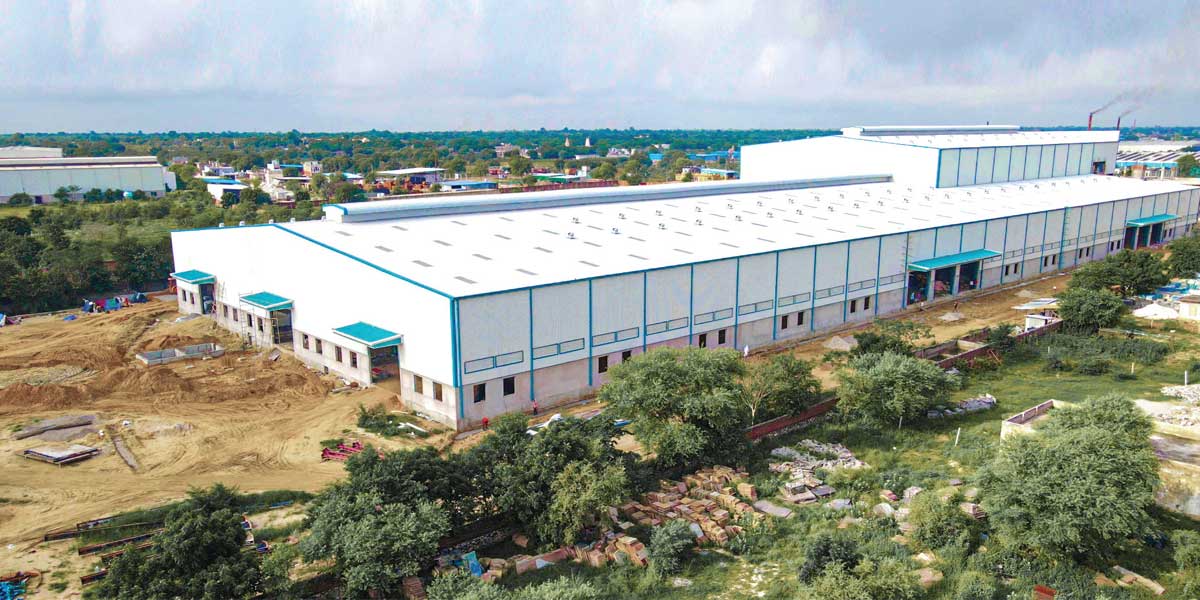What steel is usually used for PEBs?
PEBs include built-up
sections, hot-rolled sections,
cold-formed sections and
roof and wall sheets, explains
Nikhil Bothra, Managing
Director, EPACK Prefab.
Bothra elucidates the kind
of steel used for each of
these sections:
Built-up sections for primary members like
columns, rafters, mezzanine beams, joists,
crane beams and brackets are usually made
in ASTM A 570 (Grade 50) / IS: 2062 or
equivalent steel with a minimum yield
strength of 345 MPa.
Hot-rolled sections for primary members like
bracings, framed openings, tie beams, sag
rods, staircase members, handrails, cage
ladders and walkway members are usually
made in ASTM A 572 (Grade 36) / ASTM A36
/ IS 4923 / IS 1161 or equivalent steel with a
minimum yield strength of 245 MPa.
Cold-formed sections for secondary
members like purlins and girts are usually
made in ASTM 653 (Grade 50) / IS 811 or
equivalent steel with a minimum yield
strength of 345 MPa.
Roof and wall sheets are usually made
in ASTM A 792 M / IS 15965 (Grade 550
MPa and 345 MPa) with a minimum yield
strength of 550 MPa or 345 Mpa. These are
usually pre-painted galvalume steel sheets
with different types of top coatings
– regular modified polyester, silicone
modified polyester, super durable polyester
and polyvinylidene difluoride. In many
applications, bare galvalume steel sheets
of the same grade are also used. These
types of sheets are coated with weather
protective coatings for its durability and
wide acceptance.
“Mainframe members like columns, rafters,
beams and joists are made of grade 50,
minimum 345 MPa yield strength while cold
form members like purlins and girts are made of
high tensile 345 MPa minimum yield strength,”
says Manish Garg, CEO, Interarch Building
Products. “The roof and wall cladding is made of
cold-rolled, high tensile galvalume steel of grade
80, minimum 550 MPa yield strength.”
What change are we seeing in the use of
steel for PEBs?
PEBs typically used standard 345 MPa
grade steel in the form of hot-rolled plates, coils
and cold-rolled steel,
says D Raju, Managing
Director, Kirby Building
Systems & Structures India.
“However, the increasing
popularity of PEBs across
India for a wide range of
applications has improved
the availability of raw materials being locally
manufactured in India by OEMs. The industry
is now using higher grade 450 MPa steel for
high-rise buildings and other structures
as required while 345 MPa grade steel
continues to be used for industrial and
warehouse buildings. Steel makers are
increasingly providing construction materials
that enable energy-efficient and low carbon
neutral buildings.”
What are the biggest challenges facing
the PEBs segment in India?
Limited know-how has restricted the
adoption of PEBs in India, says Bothra. “People
trust traditional construction more than PEBs
since the latter concept is still new in India.
However, government initiatives and other
factors are contributing to the rise in the
awareness of the benefits of PEBs, and so, their
demand is set to rise. Most public buildings
are pre-engineered and made of steel. Besides,
traditional construction methods have not
been successful in meeting the
construction demands from logistics and
warehousing sectors.”
What factors encourage the use of
prefabricated steel buildings?
Nest-In prefab construction is two to three
times faster than conventional brick-and-mortar
construction, says Ashish Anupam, Managing
Director, Tata Steel Long
Products. “It cuts down
almost 70 per cent of the
weight of traditional
construction, as it requires
less foundation, less waste
disposal and redeployment
costs. Nest-In structures also
have a superior strength-to-weight ratio, which
lends them a high tolerance to adverse weather
conditions, strong winds, and earthquakes.
Nest-In has collaborated with IIT Hyderabad to
provide structural stability certifications for its
structures, which are designed for a life up to
50 years.” Nest-In offers solutions for large
infrastructure projects through HabiNest, a
Light Gauge Steel Frame (LGSF) construction
technology; modular solutions for sanitation
through EzyNest modular toilets, portable
cabins through MobiNest; and premium home
solutions to retail customers through Nestudio,
a premium PUF panel-based housing solution,
adds Anupam.
“HabiNest buildings are constructed in
almost one-third the time it takes for conventional
construction and provide environmental savings
in the range of 48-61 per cent over a range of
lifecycle categories in comparison to similar
brick-and-mortar structures,” continues Anupam.
“Nest-In has constructed a hostel complex
spanning 14,000 sq ft and a medical college
campus with G+3 buildings spanning 2.5 lakh sq
ft for clients using LGSF technology.”
Population explosion and the lack of space
in urban areas will spur fast-paced vertical
construction, says Bothra. “Constructing a multilevel
structure demands the deployment of
strong, lightweight materials. Steel allows the
construction of large spans and lightweight
structures by virtue of its high strength. PEB
steel structures can withstand rough weather
conditions like wind loads better than structurally
rigid concrete. Also, steel is 100 per cent
recyclable and therefore, does not deplete
the environment.”
How does the PEB industry in India
compare with the market overseas?
Mature PEB markets in the Middle East and
Europe are much ahead of India, opines Raju.
“The PEB industry took root in India in around
2000, while the Middle East saw its first PEBs
30 years prior to India and Europe saw the
emergence of the PEB industry in the 1940s.
Mature markets use PEBs more innovatively
than India. That said, India is now seeing the
construction of not only warehouses but also
complex industrial buildings and high-rise
structures with PEB technology. Kirby India has
ventured into the construction of commercial
buildings either completely in steel or in a
composite form that is slowly being accepted by
developers in major cities across the country.
We are currently implementing a commercial
office building of G+20 floors, and expect this
trend to continue.” Steel buildings engineered,
manufactured and supplied by organised PEB
players in India meet global standards, opines
Garg. “Indian PEB offerings are at par with
mature Middle Eastern markets. Europe
generally does not utilise pre-engineered
buildings and mainly uses steel construction.”
What regions in India are ahead in the
PEB adoption curve?
As the desire for eco-friendly buildings
increases, the usage of pre-fabricated steel
structures has become a prominent and most
convenient construction method in India,
observes VR Sharma, Managing Director, Jindal
Steel and Power. “In addition to allowing
construction in an eco-friendly manner, the
pre-fabricated steel structure provides flexibility
in building designs and helps speedy execution
with minimal manpower. We have witnessed a
shift to structural steel based construction
methods in Andhra Pradesh, Telangana, Tamil
Nadu, Karnataka, Haryana and Delhi majorly due
to a shortage of workers and scarcity of
construction materials. We see such trends
in Noida also. The rest of India will eventually
follow. In the coming decade, I foresee the
widespread adoption of steel structures as a
major construction material in buildings
and housing.




















